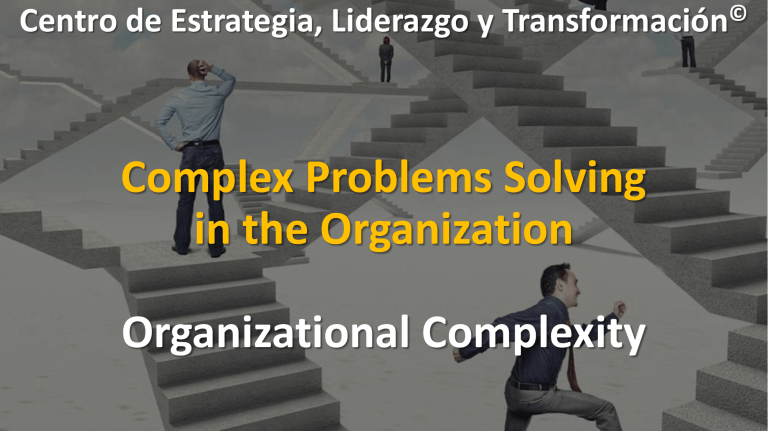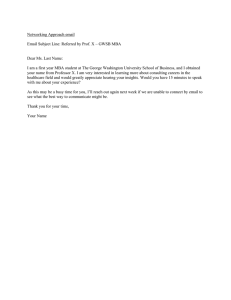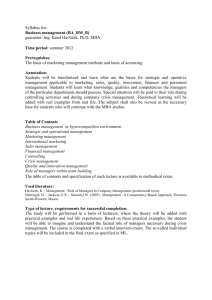
Centro de Estrategia, Liderazgo y Transformación© Complex Problems Solving in the Organization Organizational Complexity Today's organization is caught between the paradigms of the past that prevent it from becoming more dynamic and flexible. In recent years they have unsuccessfully searched for formulas that allow them to survive in an increasingly dynamic and turbulent competitive environment. However, the changes have been partial and they have not managed to adapt the essence of the business according to the new and incremental demands of the environment. Despite everything, we know that organizations must learn to co-evolve and adapt their structures in this new environment if they want to remain within the competitive arena. Carson, Flood, 1990 Dealing with Complexity © Why Organizational Complexity? 15 (s) (r) 10 e 1 2 r 0 1 es 2 4 3 3 8 4 6 16 5 10 32 6 15 64 05 0 1 2 3 4 5 6 The more elements the organization has, and the greater number of relationships and situations that can arise, the greater the number of systems, departments, roles, functions, procedures, policies, etc. should be to properly manage the system. How many types of Complexity a) Complexity of Origin: Due to the characteristics of the organization and its nature, for example. 3M vs Budweiser. b) Residual Complexity: This type of complexity is related to the daily operation of the system, for example conflict triggered by silos, cancellation of orders, delay of delivery supplies, staff turnover, etc. c) Caused Complexity: Complexity that is generated by biased and personal decisions, for example, buying the wrong technology, hiring the wrong executive, launching products without adequate analysis, etc. Elements to better understand Complexity We live in an increasingly dynamic world that requires us to pay more and more attention to detail to achieve permanent success. These challenges confront us with everyday situations that could be called complicated or complex, however, it is important to make the distinction. The complicated can be solved; it will take time, energy, effort, and the systematic application of techniques and tools. On the contrary, when we say that something is complex it is because we are faced with a situation full of interactions that are dynamically connected, and whose effects are sometimes not immediate, but will be perceived in time due to the occurrence of delays . There are some general properties that we can comment on as particular to complex situations and to which we must pay attention, in order to diagnose and solve the situation in the direction of optimization, and not in the opposite direction. Big Picture We must be able to distinguish between seeing simultaneously the "Forest and the trees." Complex situations require a systemic vision of reality, identifying the parts, components, and their interactions, at different levels of focus. We must observe the different elements or components that participate in a situation, and if there is conflict between them. So, we must also carefully observe the structures that are causing behaviors in the differents situations. Short, medium and log term The complexity of the systems dictates that many of the results that we expect to see in the short term cannot be seen except medium and longer terms. Remember that systems involve properties that demand stabilization and learning curves between the parts. Likewise, many of the mistakes we have made have an impact for future times. All this is thanks to the fact that the line that separates causes and effects in a system is not always immediate but is affected by delays. For this reason, it is not recommended to rely on instinctive and easy short-term solutions, because hidden long-time effects eventually will appear. Dynamic interdependence Complex situations are not only the connection of a small number of variables; when we analyze in depth, we will discover a large number of elements participating with multiple interactions. That in reality means that it is not so simple to attack and solve a problematic situation, if we do not truly understand "the wiring" that connects the variables, components, causes and consequences. Additionally, connection patterns between elements change over time, so something that worked in the past will not necessarily work the same in the future. Non intended consequences Complex situations require a real analysis to be understood and solved. Each situation is a set of right guess, errors and opportunities not fully exploited in the past. Many times, we can act with good intentions, but if we do not fully understand the system, we can reduce its performance causing an irremediably inverse effect to what we were expecting. Thus, some "steamed" decisions can cause us to reduce our productivity, decrease motivation or lower sales instead of increasing them. Alfonso Cornejo Consultant with 25 years of experience. Author of 2 books on Organizational Complexity. Associate professor at EGADE MBA in México and UIDE International MBA in Ecuador. Competences: Strategic Thinking, Complex Problems Solving, Organizational Development and Cultural Transformation. Contacto ACCELUM Consulting Network Groundwork Ave Lázaro Cárdenas No. 1007, 2o Piso Valle Oriente, San Pedro Garza García, NL. CP 66266, MX Tel. + 52 81 8220 9075 CP. + 52 81 8029 7783 accelum@gmail.com



